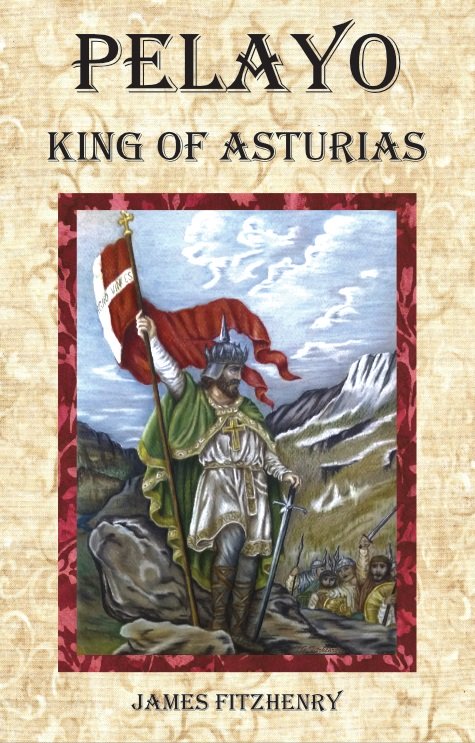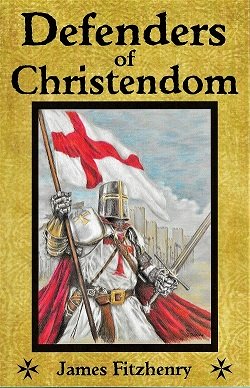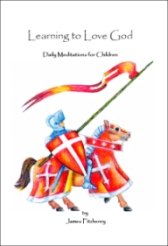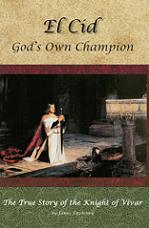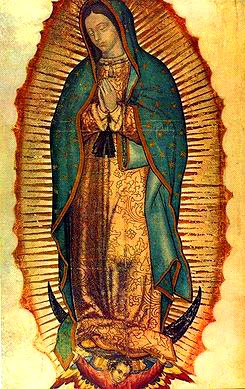
Our Lady of Guadalupe
Our Lady of Guadalupe
(Nuestra Senora De Guadalupe)
Mexico. The year of Our Lord 1531. Ten years and four months before, Hernan Cortes had accomplished the subjugation of the proud Aztec nation. And now, scarcely a decade later, a million and a half of the indigenous population had already embraced baptism and the Faith of Christ. On the ninth day of December in the year we speak of, one of these Indians, Juan Diego by name, left his humble dwelling in Cuautitlan. Juan was on his way to hear Mass at the Church of Santiago, in the barrio of Tlaltecloco. His way led past a hill called by the Indians Tepeyacac, and as dawn was breaking he arrived at the foot of the hill.
Suddenly there came to his ears the sound of sweet singing, like the voices of birds myriad and various, singing together with such ineffable harmony that the Indian was overcome with wonder and delight. Raising his eyes to the summit of Tepeyacac, Juan saw as it were a white and shining cloud, and within it a rainbow of color, with rays of dazzling light. The Indian stood spellbound, yet unafraid, filled with a sweet amazement, and asked himself whether it were all a dream.
“What is this I hear and see? Where am I? By chance have I been transported to that Paradise of Delights where our race came into being? Or is it some heavenly country, hidden from the eyes of men?
The singing was stilled, but the Indian remained in a kind of enchantment, gazing at the shining cloud above him on the hill. And then he heard a voice, a woman’s voice, soft and clear, calling to him from the midst of the cloud: “Juan! Juan!” Could he be hearing aright? Was the voice calling him? There it came again, this time more sweetly insistent: “Juan! Come closer!”
Gone was all hesitation. Almost in a bound Juan Diego reached the little eminence and stood just below the shining cloud. And then Juan saw her! Within the shining cloud there stood a beautiful Lady. The radiance of her garments transformed into the likeness of precious jewels the stones beneath her feet, and the leaves of the hawthorn and nopal appeared clusters of rare emeralds on surfaces polished and glowing. The very soil had become a carpet of jasper, tinted in many colors.
“My son, Juan Diego, whom I love tenderly, like a small and delicate child! Where are you going?” The Lady’s words were spoken in Nahuatl, the language of Juan’s people. Who can reproduce their delicacy of feeling in any other tongue?
“O noble Mistress and my Lady,” Juan answered, “I am going to Mexico, to the barrio of Tlalteolco, to hear the Mass, which the ministers of God present for us in His place.”
“Know, my beloved son,” replied the Lady, “that I am the Ever-Virgin Mary, Mother of the true God, who is the Author of Life, the Creator of all things and the Lord of heaven and earth; who is everywhere. It is my wish that you build me a temple on this site. Here, as the loving Mother of you and of your fellow men, I will show forth my living kindness and compassion for your people and for those who love me and seek me, and call upon me in their labors and afflictions. Here I will hear their cries and their petitions, I will comfort and assuage. In order that my will may be accomplished, you must go to Mexico, to the palace of the Bishop who resides there. You are to tell him that I sent you, and that it is my pleasure that he build me a temple in this place. You will relate to him what you have seen and heard. And be certain of this: I will be grateful for what you do for me in this matter with which I charge you, and I will raise you up and make you renowned because of it. My son, you have heard my wish. Go in peace. And bear in mind that I will repay the labor and care that you employ; so in this matter exert all your strength.”
On his knees and with head to the ground, Juan Diego answered: “I go, most noble Lady and my Mistress, as your humble slave, to carry out your order.”
And so the Indian took leave of the Lady.
He descended the western slope of the hill and took the road into the City of Mexico, a league distant. As he had promised the Lady, Juan went directly to the palace of the Bishop, Fray Juan de Zumarraga. He asked the servants to tell the Bishop he wanted to see him; but, because of the early hour, and because they saw only an Indian of the poorest class, the servants simply let him wait. Finally, however, struck by his patience, they let him in, to audience with the prelate. On his knees before the Bishop, Juan poured out his story. Bishop Zumarraga listened to the extraordinary tale and questioned Juan closely. In the end he sent the Indian away, telling him to return in some days.
Sorrowfully Juan left the palace. The Bishop, he felt, had not believed the story. What was more important to Juan Diego, he had failed to carry out the will of the Blessed Lady. With heavy heart he began the journey to his pueblo, Tolpetlac.
It was after sunset when he reached the summit of Tepeyacac. The Lady was waiting for him. As soon as Juan saw her, he prostrated himself in obeisance and began to speak. But what other tongue can adequately convey the beauty and gentleness, the courtesy, the delicate nuances, of Juan Diego’s native Nahuatl? Listen: “My well-beloved Daughter, my Queen and Lady most high! I did what you commanded me, although I did not talk to the Bishop until after a long wait. I gave him your message in the form you commanded me; he heard me calmly and with attention. But, from what I observed in his manner, and from the questions which he put to me, I gathered that he did not believe me; for he told me to come back at a later date, so that he might investigate the matter at length. He thinks that the temple you wish to be built for you is a tale of my own making, or my own fancy rather than your will. So I pray you, for this work send some noble and important personage, worthy of respect, whom he will believe. For as you see, my Mistress, I am only a poor rustic, a lowly man of the people, and unsuited for this business on which you send me. Pardon my boldness, my Queen, if I have failed in the reverence due to your high station. Let not your wrath fall upon me, nor may my answer displease you.”
The Most Holy Mary listened to his tale with a benign countenance, and then answered:
“Listen, my well-beloved son. Know you that I do not lack servants nor domestics under my command. For I have many whom I can send, if I wish, who will do what they are commanded. But it is fitting that you undertake this affair. It is through your intervention that my will and my desire must be done. So I ask you, my son, and I order you, to return tomorrow, to see and talk to the Bishop. Tell him to build me the temple that I ask, and tell him that she who sends you is the Virgin Mary, Mother of the true God.”
“Do not be displeased, O Queen and my Lady,” Juan Diego replied, “at what I have said. For I shall go willingly and with all my heart to obey your command and to carry your message. I was not making excuses, nor do I fear the journey nor the task. But perhaps I shall not be received nor listened to; or perhaps the Bishop, once he has heard me, will not believe.
Nevertheless, I shall do what you command me. And I shall be waiting, Lady, tomorrow at sunset in this place, to give you the answer. And so remain in peace, and may God watch over you!”
Even through the dim medium of a translation twice removed from the original tongue, the delicacy of expression of this humble, unlettered man comes to us clearly, to our wonder and delight. With reverence Juan Diego took his leave and continued on the way to his home in Tolpetlac. As far as we know, he said not a word to anyone about the matter. Perhaps, overcome by the events of the day and disturbed that the Bishop had not believed the events, he had decided to keep his own counsel for the time being.
The next day, December the tenth, was Sunday, and Juan went to the Church of Santiago in Tlaltelolco for Mass and the class in Christian doctrine which the Indian converts had to attend. Then he went again to the palace of the Bishop. Once more the servants made him wait a long time, but finally he was admitted.
Once more, prostrate and with tears and urgent words, Juan related to Bishop Zumarraga “…how for the second time he had seen the Mother of God in the same place that he had seen her the first time. That she was waiting for the reply to the message which she had given him earlier. That once again she had commanded him to go and tell the Bishop to build her a temple on the very site where he had seen and talked to her. That he should tell the Bishop that she who sent him was the Mother of Jesus Christ and the Ever-Virgin Mary.”
The Bishop listened with greater attention this time, and began to think that there might be something to the tale. He questioned and re-questioned Juan Diego very closely, warning him to weigh his words carefully. He asked Juan to describe the appearance of the Virgin, and satisfied himself that it could be neither dream nor imagination. Yet, as Bishop, he could not appear to accept lightly such a tale from the lips of a simple Indian. So he replied:
“What you have told me is not enough to make me undertake the task that you request. Therefore, tell the Lady who sent you to give you other signs, by which I may know that it is the Mother of God who sent you, and that it is he will that we build her a temple.”
“What sign would you like me to ask for?” said Juan.
The calmness and confidence of Juan Diego strangely disturbed the Bishop. The Indian spoke as though the sign were as good as granted. And so the Bishop answered:
“Let the Lady choose whatever sign seems good to her.”
Then he summoned several of the most trusted servants in his household. Speaking to them in Spanish, which Juan did not understand, the Bishop told them to follow Juan without his knowledge, to report upon what he did and with whom he spoke. The servants followed Juan, easily keeping him in sight until he arrived at a little bridge crossing a stream, almost at the foot of Tepeyacac. Here the Indian disappeared from their sight, and although the servants looked everywhere, searching the hill on every side, Juan could not be found. They took him for either an impostor or a wizard, and returned to tell the Bishop what had occurred, asking him to punish the Indian if he should again come to the palace.
When Juan reached the summit of the hill, the Virgin was waiting for him. On his knees he told her what had happened: “…how,” as the most ancient recital has it, “carrying out her command, he had returned to the palace of the Bishop and had given him her message. And that, after questions and cross-questions, the Bishop had said that this simple tale was not sufficient to make him take action in so serious a matter.”
Juan continued his relation:
“I am to ask you, O Lady, for a particular sign, by which he may know that you sent me, and that it is your will that temple for you be built on this site.”
With loving words Mary commended the care and diligence of Juan. She told him to return on the morrow, when she would give him a sign that the Bishop would believe. Juan promised to return, and took his leave of the Sovereign Lady.
But on the next day, Monday, December the eleventh, Juan was unable to keep his promise. Upon reaching his pueblo, he found that his uncle, Juan Bernardino, was seriously ill. The greater part of the day Juan spent in looking for a curandero (native medicine man) and when finally he found one, the latter’s ministrations only made the sick man worse. Juan Bernardino requested his nephew to go early on Tuesday to the Convent of Santiago at Tlaltelolco, for a priest who would administer the last rites of the Church. Before daybreak on Tuesday, December the twelfth, therefore, Juan Diego set out for Tlaltelolco. But when he arrived at the foot of Tepeyacac, and was about to take the trail over the hill, he recalled his neglected promise to the Lady. Thinking that she would reproach him, he determined to avoid a meeting by skirting the hill. But as Juan approached the spot where today there is a spring of sparking water, Mary came forth to meet him.
Encompassed by a shining cloud, she came down the hill, directly across his path, and spoke: “Where are you going, my son, and what road are you taking?”
Struck with shame and fear, the Indian fell to the ground and answered:
“My beloved Daughter and my Lady, may God watch over you! Do not be displeased at what I am going to tell you. Know, my Mistress, that one of your servants, my uncle, is gravely ill and about to die, and as he seems very weak I am going to the temple of Tlaltelolco for a priest to confess and anoint him. After having discharged this duty I will return here to obey your command. Forgive me, I pray you, my Lady, and bear with me a little. I am not asking to be excused from doing what you have commanded, nor is it a false excuse I give you. Tomorrow I will return without fail.”
Mary heard the Indian’s story with understanding in her face, and then spoke to him in this manner:
“Listen, my son, to what I tell you now. Do not let anything worry or afflict you; do not fear illness nor any troublesome happening nor pain. Am I not here, I who am your Mother? Are you not under my shadow and protection? Am I not your life and health? Are you not in my embrace and in my prayers? What else do you need? Have no care nor worry about the illness of your uncle, for he will not die from it. Rest assured that he is already well.”
Consoled by the words of Our Lady, Juan replied: “Then send me, by Lady, to see the Bishop, and give me the sign of which you spoke so that he will believe me.”
And Mary answered: “My dearly beloved son, go up to the summit of the hill where you have seen me and talked with me, and cut the roses which you find there. Gather them into your cloak and bring them to me. I will tell you what you are to do and say.” Without another word Juan obeyed, although he knew that the rocky summit had never produced flowers, nor vegetation of any kind. But, arriving at the top, he found a beautiful garden of Castilian roses, fresh and fragrant and covered with dew. Laying out his tilma (mantle), he gathered into it as many roses as it would hold, and carried them to Mary. And Mary gathered up the roses and rearranged them in the mantle of Juan Diego, saying: “You see here the sign which you are to take to the Bishop. Tell him, by the sign of these roses, to do what I order him. And pay attention, my son, to what I am telling you, and know that I have confidence in you. Show no one on the way what you are carrying, nor open your cloak except in the presence of the Bishop, and tell him what I sent you for. This will convince him that he is to start work on my temple.”
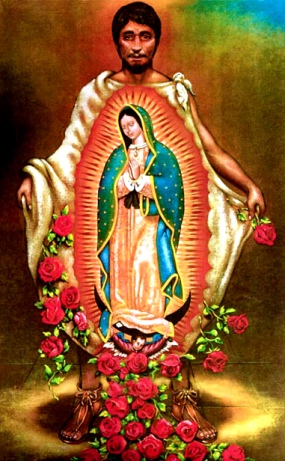
And so saying, the Virgin sent him away.
At the Episcopal palace, Juan Diego asked to see Bishop Zumarraga; but as before, the retainers saw only a humble Indian, and paid him little attention. Finally someone became curious about what he was carrying so carefully in his tilma, but Juan refused to show them. With some force they pulled at the cloak, and obtained a glimpse of the roses. At this discovery the retainers informed the Bishop, and Juan was brought into his presence. The Indian gave him Our Lady’s message, and added that he had brought from her the sign which the Bishop had demanded. When he let fall the ends of his mantle, a shower of roses covered the floor, and upon his garment was seen the image of Our Lady, just as Juan had seen her on the hill of Tepeyacac. The astonished Bishop venerated the miraculous image before his entire household and then bore it reverently to his private chapel.
Later, Juan was conducted, with signs of great respect, to the home of Juan Bernardino, by Spaniards who were commissioned to investigate the cure of the old man. Juan Bernardino related how the Most Holy Virgin had visited him at the very moment his nephew affirmed the cure had taken place, and had perfectly restored his health. The Virgin also told him "...that it was her pleasure for a temple to be erected for him in the place where his nephew had seen her; and also that her sacred image was to be called Santa Maria de Guadalupe."
Such is the story as it happened, told without embellishment. Why Our Lady called her image Guadalupe she did not say, nor shall we know, until she herself reveals it to us. At any rate, the title is not to be confused with that of the image of Our Lady of Guadalupe in Extremadura, Spain, said to have been sculptured by Saint Luke, and representing the Divine Maternity of the Blessed Virgin. Juan Bernardino, speaking the Nahuatl language, most probably called the Virgin Xanta Malia Tecuauhtlanopeuh, which signifies, "Saint Mary, she who appeared on the rocky summit."
What we do know is that the Virgin of guadalupe united the tribes and races of Mexico into a nation, for all recognize her as their Mother. Of the million and a half Indians baptized by 1531, almost all had been among the poor and the children. The noble Aztec families, mindful of their former glory, had nourished resentment of the Spanish conquerors and their religion. But with the miracle of Guadalupe, class distinctions were put aside, and noble and comoner, landholder and peasant, cacique and tribesman, embraced the Faith. Six years after Tepeyacac there were nine million converts among the Indiands, embracing he nucleus of all the nations among the tribes in the valley of Anahuac. Mexico thus became the first Christian nation of the American continent.
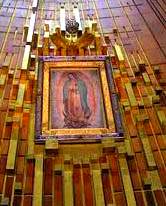
The first little temple was finished, and the miraculous image placed therein on the twenty-sixth of December, 1531. This temporary structure was replaced by one of adobe, built at the expense of Bishop Zumarraga, and finished in 1533. The sacred image remained there until November, 1622, when Archbishop Juan de la Serna solemnly blessed a new collegiate church on the site. In 1895 the reconstruction of that edifice was completed for the Pontifical Coronation of the image of Our Lady of Guadalupe. In 1931 a further reconstruction was carried out, to commemorate the four-hundredth anniversary of the apparitions.
*from Mexico land of Mary's Wonders, Joseph L. Cassidy
The beautiful image of the Blessed Virgin is obviously of miraculous origin, and science is at a loss to explain it. Those who honestly seek God will find proof of his existence here.
The fabric which the tilma was made of should have deteriorated after 20 years, yet it is hundreds of years old and in good condition. This is impossible for science to explain. An analysis of the image shows that there was no sketch made prior to the image being produced, and that it was made without brush strokes. Modern science is unfamiliar with the substance used to produce the image. Even though the fabric is course, the images of several people can be seen reflected in the eyes of the Virgin, just as they would be in a living person's eyes. The placement of those images, and the distortion that is the effect of the curve of a normal eye, is impossible to reproduce on a flat surface. The stars about Our Lady on the mantle coincide with the constellations that were in the sky on December 12, 1531.
In 1921 a bomb was placed before the image by those who hate God and His Holy Catholic Church. It exploded with such force that a heavy cast iron crucifix was bent backwards, a marble communion rail destroyed, and yet the tilma remained completely undamaged!
The result of this act of hatred and violence against the Church and Our Lady obviously did not have the effect that the perpetrators intended, for their act further confirms that the miraculous preservation of the image is supernatural in origin and enjoys the protection of Christ and his holy Mother!
Return to Marian Calendar December from Our Lady of Guadalupe
Return to Titles of Mary from Our Lady of Guadalupe
Return to Roman Catholic Saints Blog
Return to Roman Catholic Saints Homepage from Our Lady of Guadalupe
NOW AVAILABLE!!
Pelayo's resistance initiated the nearly 800-year-long Reconquista to take back his country from the ruthless invader who had conquered his homeland and sought to erase his culture and his faith. His actions would lay the foundations of a Kingdom for Christ that would eventually reach around the world and spread the Catholic faith to millions of souls. Read more...
Please help us continue to bring high quality books to our readers at the lowest possible price! Click the link below! Thank you!
Now Available!
Defenders of Christendom
Battles - Honor - Miracles!
This book is filled with
amazing stories of little-known
Catholic heroes presenting
spectacles of bravery and
valor never exceeded in all the annals of history.
Demonstrating his
gallantry through daring feats
of arms, the knight's faith,
coupled with his marvelous
courage, made him nearly
invincible on the field
of battle.
read more . . .
Defenders of Christendom is
Learning to Love God
Especially for young children -
Now available as an e-book!
Available for only $2.99 US
as an ebook download.
Also available in Spanish!
The exciting life story of
the holy Catholic knight
known as El Cid!
Available for only
$22.95
The amazing life story of the
little known incorrupt saint
- King Fernando III!
This highly acclaimed book is
inspirational to young men
and a guide to building a strong
masculine, Catholic character!
Also available as softback!



